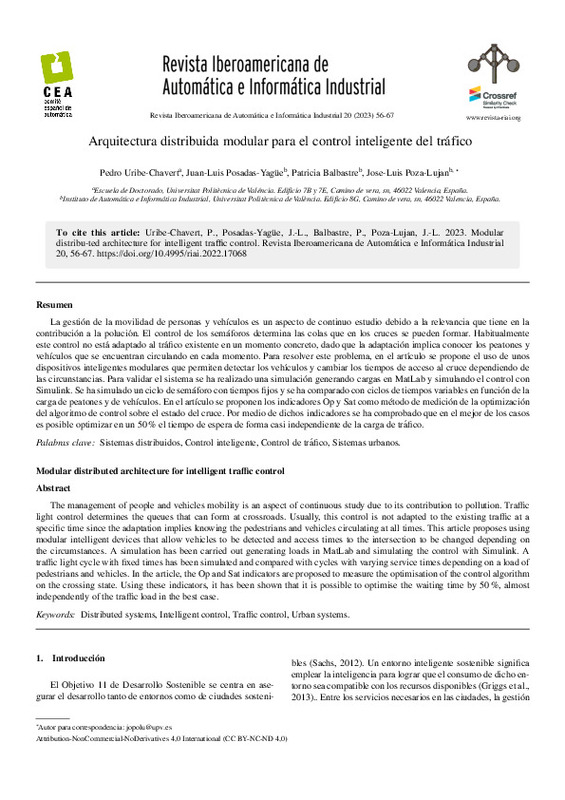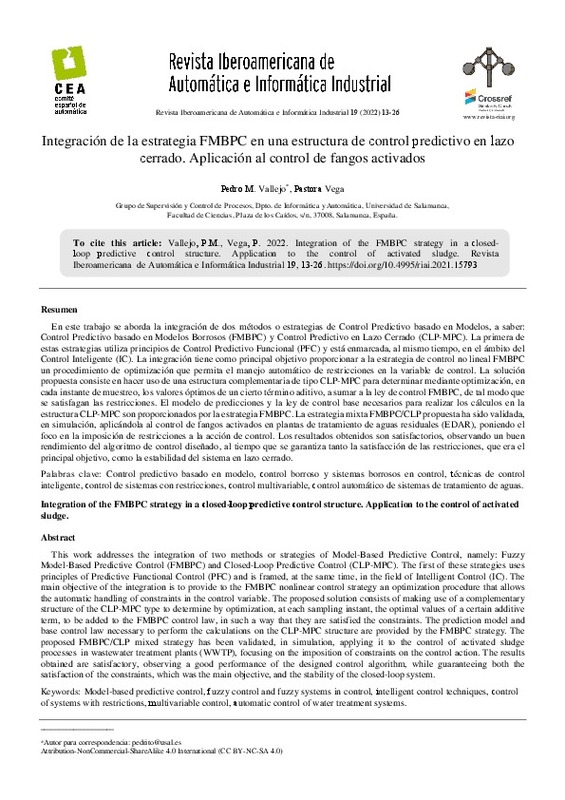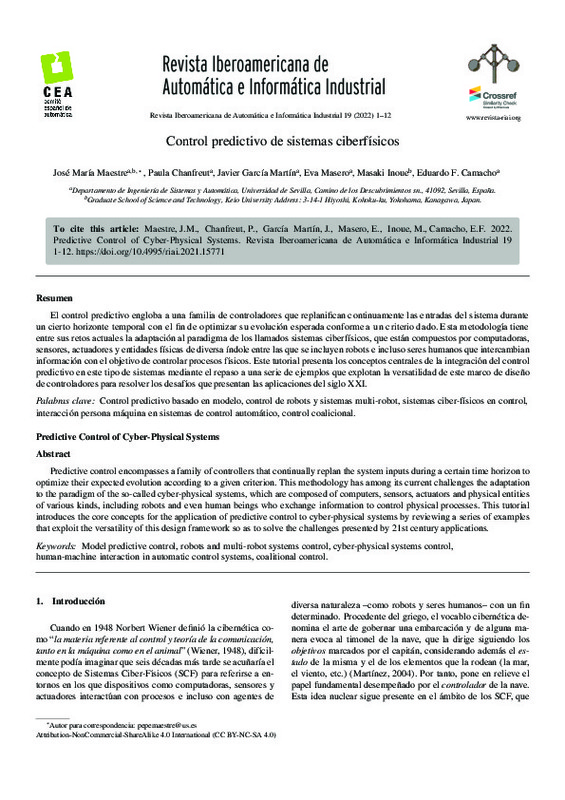JavaScript is disabled for your browser. Some features of this site may not work without it.
Buscar en RiuNet
Listar
Mi cuenta
Estadísticas
Ayuda RiuNet
Admin. UPV
Arquitectura distribuida modular para el control inteligente del tráfico
Mostrar el registro sencillo del ítem
Ficheros en el ítem
| dc.contributor.author | Uribe-Chavert, Pedro
|
es_ES |
| dc.contributor.author | Posadas-Yagüe, Juan-Luis
|
es_ES |
| dc.contributor.author | Balbastre, Patricia
|
es_ES |
| dc.contributor.author | Poza-Luján, José-Luis
|
es_ES |
| dc.date.accessioned | 2023-01-17T08:28:13Z | |
| dc.date.available | 2023-01-17T08:28:13Z | |
| dc.date.issued | 2022-12-28 | |
| dc.identifier.issn | 1697-7912 | |
| dc.identifier.uri | http://hdl.handle.net/10251/191367 | |
| dc.description.abstract | [EN] The management of people and vehicles mobility is an aspect of continuous study due to its contribution to pollution. Traffic light control determines the queues that can form at crossroads. Usually, this control is not adapted to the existing traffi at a specific time since the adaptation implies knowing the pedestrians and vehicles circulating at all times. This article proposes using modular intelligent devices that allow vehicles to be detected and access times to the intersection to be changed depending on the circumstances. A simulation has been carried out generating loads in MatLab and simulating the control with Simulink. A traffic light cycle with fixed times has been simulated and compared with cycles with varying service times depending on a load of pedestrians and vehicles. In the article, the Op and Sat indicators are proposed to measure the optimisation of the control algorithm on the crossing state. Using these indicators, it has been shown that it is possible to optimise the waiting time by 50%, almost independently of the traffic load in the best case. | es_ES |
| dc.description.abstract | [ES] La gestión de la movilidad de personas y vehículos es un aspecto de continuo estudio debido a la relevancia que tiene en la contribución a la polución. El control de los semáforos determina las colas que en los cruces se pueden formar. Habitualmente este control no está adaptado al tráfico existente en un momento concreto, dado que la adaptación implica conocer los peatones y vehículos que se encuentran circulando en cada momento. Para resolver este problema, en el artículo se propone el uso de unos dispositivos inteligentes modulares que permiten detectar los vehículos y cambiar los tiempos de acceso al cruce dependiendo de las circunstancias. Para validar el sistema se ha realizado una simulación generando cargas en MatLab y simulando el control con Simulink. Se ha simulado un ciclo de semáforo con tiempos fijos y se ha comparado con ciclos de tiempos variables en función de la carga de peatones y de vehículos. En el artículo se proponen los indicadores Op y Sat como método de medición de la optimización del algoritmo de control sobre el estado del cruce. Por medio de dichos indicadores se ha comprobado que en el mejor de los casos es posible optimizar en un 50 % el tiempo de espera de forma casi independiente de la carga de tráfico. | es_ES |
| dc.description.sponsorship | Ministerio de Ciencia e Innovación de España Proyecto MICINN: CICYT PRECON-I4: Sistemas informáticos predecibles y confiables para la Industria 4.0 TIN2017-86520-C3-1-R | es_ES |
| dc.language | Español | es_ES |
| dc.publisher | Universitat Politècnica de València | es_ES |
| dc.relation.ispartof | Revista Iberoamericana de Automática e Informática industrial | es_ES |
| dc.rights | Reconocimiento - No comercial - Compartir igual (by-nc-sa) | es_ES |
| dc.subject | Distributed systems | es_ES |
| dc.subject | Intelligent control | es_ES |
| dc.subject | Traffic control | es_ES |
| dc.subject | Urban systems | es_ES |
| dc.subject | Sistemas distribuidos | es_ES |
| dc.subject | Control inteligente | es_ES |
| dc.subject | Control de tráfico | es_ES |
| dc.subject | Sistemas urbanos | es_ES |
| dc.title | Arquitectura distribuida modular para el control inteligente del tráfico | es_ES |
| dc.title.alternative | Modular distributed architecture for intelligent traffc control | es_ES |
| dc.type | Artículo | es_ES |
| dc.identifier.doi | 10.4995/riai.2022.17068 | |
| dc.relation.projectID | info:eu-repo/grantAgreement/AEI/Plan Estatal de Investigación Científica y Técnica y de Innovación 2013-2016/TIN2017-86520-C3-1-R/ES/SISTEMAS INFORMATICOS PREDECIBLES Y CONFIABLES PARA LA INDUSTRIA 4.0/ | es_ES |
| dc.rights.accessRights | Abierto | es_ES |
| dc.contributor.affiliation | Universitat Politècnica de València. Instituto Universitario de Automática e Informática Industrial - Institut Universitari d'Automàtica i Informàtica Industrial | es_ES |
| dc.contributor.affiliation | Universitat Politècnica de València. Departamento de Informática de Sistemas y Computadores - Departament d'Informàtica de Sistemes i Computadors | es_ES |
| dc.contributor.affiliation | Universitat Politècnica de València. Escola Tècnica Superior d'Enginyeria Informàtica | es_ES |
| dc.contributor.affiliation | Universitat Politècnica de València. Escuela Técnica Superior de Ingenieros Industriales - Escola Tècnica Superior d'Enginyers Industrials | es_ES |
| dc.description.bibliographicCitation | Uribe-Chavert, P.; Posadas-Yagüe, J.; Balbastre, P.; Poza-Luján, J. (2022). Arquitectura distribuida modular para el control inteligente del tráfico. Revista Iberoamericana de Automática e Informática industrial. 20(1):56-67. https://doi.org/10.4995/riai.2022.17068 | es_ES |
| dc.description.accrualMethod | OJS | es_ES |
| dc.relation.publisherversion | https://doi.org/10.4995/riai.2022.17068 | es_ES |
| dc.description.upvformatpinicio | 56 | es_ES |
| dc.description.upvformatpfin | 67 | es_ES |
| dc.type.version | info:eu-repo/semantics/publishedVersion | es_ES |
| dc.description.volume | 20 | es_ES |
| dc.description.issue | 1 | es_ES |
| dc.identifier.eissn | 1697-7920 | |
| dc.relation.pasarela | OJS\17068 | es_ES |
| dc.contributor.funder | Agencia Estatal de Investigación | es_ES |
| dc.description.references | Al-qutwani, M.,Wang, X., 2019. Smart traffic lights over vehicular named data networking. Information 10 (3), 83. https://doi.org/10.3390/info10030083 | es_ES |
| dc.description.references | Banister, D., 2011. Cities, mobility and climate change. Journal of Transport Geography 19 (6), 1538-1546. https://doi.org/10.1016/j.jtrangeo.2011.03.009 | es_ES |
| dc.description.references | Beaver, L. E., Chalaki, B., Mahbub, A. I., Zhao, L., Zayas, R., Malikopoulos, A. A., 2020. Demonstration of a time-efficient mobility system using a scaled smart city. Vehicle System Dynamics 58 (5), 787-804. https://doi.org/10.1080/00423114.2020.1730412 | es_ES |
| dc.description.references | Burguillo-Rial, J. C., Rodriguez-Hernandez, P. S., Montenegro, E. C., Castineira, F. G., 2012. History-based self-organizing traffic lights. Computing and Informatics 28 (2), 157-168. | es_ES |
| dc.description.references | Chen, L.-W., Chang, C.-C., 2016. Cooperative traffic control with green wave coordination for multiple intersections based on the internet of vehicles. IEEE Transactions on Systems, Man, and Cybernetics: Systems 47 (7),1321-1335. https://doi.org/10.1109/TSMC.2016.2586500 | es_ES |
| dc.description.references | De Souza, A. M., Brennand, C. A., Yokoyama, R. S., Donato, E. A., Madeira, E. R., Villas, L. A., 2017. Traffic management systems: A classification, review, challenges, and future perspectives. International Journal of Distributed Sensor Networks 13 (4), 1550147716683612. https://doi.org/10.1177/1550147716683612 | es_ES |
| dc.description.references | Gao, K., Huang, S., Han, F., Li, S., Wu, W., Du, R., 2020. An integrated algorithm for intersection queue length estimation based on iot in a mixed traffic scenario. Applied Sciences 10 (6), 2078. https://doi.org/10.3390/app10062078 | es_ES |
| dc.description.references | Griggs, D., Stafford-Smith, M., Gaffney, O., Rockström, J., Öhman, M. C., Shyamsundar, P., Steffen, W., Glaser, G., Kanie, N., Noble, I., 2013. Policy: Sustainable development goals for people and planet. Nature 495 (7441), 305. https://doi.org/10.1038/495305a | es_ES |
| dc.description.references | Hartanti, D., Aziza, R. N., Siswipraptini, P. C., 2019. Optimization of smart traffic lights to prevent traffic congestion using fuzzy logic. TELKOMNIKA. Telecommunication Computing Electronics and Control 17 (1), 320-327. https://doi.org/10.12928/telkomnika.v17i1.10129 | es_ES |
| dc.description.references | Hernandez Bel, A., 2020. Dispositivo modular configurable para la deteccion de vehıculos, y viandantes, y con soporte a la iluminacion de la va e informacion de trafico. Tech. rep., Universitat Polit'ecnica de Valencia. | es_ES |
| dc.description.references | Jang, H.-C., Lin, T.-K., 2018. Traffic-aware traffic signal control framework based on sdn and cloud-fog computing. In: 2018 IEEE 88th Vehicular Technology Conference (VTC-Fall). IEEE, pp. 1-5. https://doi.org/10.1109/VTCFall.2018.8690602 | es_ES |
| dc.description.references | Lämmer, S., Helbing, D., 2008. Self-control of traffic lights and vehicle flows in urban road networks. Journal of Statistical Mechanics: Theory and Experiment 2008 (04), P04019. https://doi.org/10.1088/1742-5468/2008/04/P04019 | es_ES |
| dc.description.references | Liang, X., Du, X., Wang, G., Han, Z., 2018. Deep reinforcement learning for traffic light control in vehicular networks. arXiv preprint arXiv:1803.11115. | es_ES |
| dc.description.references | Liu, H. X.,Wu, X., Ma,W., Hu, H., 2009. Real-time queue length estimation for congested signalized intersections. Transportation research part C: emerging technologies 17 (4), 412-427. https://doi.org/10.1016/j.trc.2009.02.003 | es_ES |
| dc.description.references | Mahoor, M., Salmasi, F. R., Najafabadi, T. A., 2017. A hierarchical smart street lighting system with brute-force energy optimization. IEEE Sensors Journal 17 (9), 2871-2879. https://doi.org/10.1109/JSEN.2017.2684240 | es_ES |
| dc.description.references | Navarro, J., Vida˜na-Vila, E., Alsina-Pagés, R. M., Hervas, M., 2018. Real-time distributed architecture for remote acoustic elderly monitoring in residential scale ambient assisted living scenarios. Sensors 18 (8), 2492. https://doi.org/10.3390/s18082492 | es_ES |
| dc.description.references | Pell, A., Meingast, A., Schauer, O., 2017. Trends in real-time traffic simulation. Transportation research procedia 25, 1477-1484. https://doi.org/10.1016/j.trpro.2017.05.175 | es_ES |
| dc.description.references | Płaczek, B., 2014. A self-organizing system for urban traffic control based on predictive interval microscopic model. Engineering applications of artificial intelligence 34, 75-84. https://doi.org/10.1016/j.engappai.2014.05.004 | es_ES |
| dc.description.references | Poza-Lujan, J.-L., Posadas-Yagüe, J.-L., Simó-Ten, J.-E., Blanes, F., 2020. Distributed architecture to integrate sensor information: Object recognition forsmart cities. Sensors 20 (1), 112. https://doi.org/10.3390/s20010112 | es_ES |
| dc.description.references | Poza-Lujan, J.-L., Uribe-Chavert, P., Sáenz-Peñafiel, J.-J., Posadas-Yagüe, J.-L., 2021. Distributing and processing data from the edge. a case study with ultrasound sensor modules. In: International Symposium on Distributed Computing and Artificial Intelligence. Springer, pp. 190-199. https://doi.org/10.1007/978-3-030-86261-9_19 | es_ES |
| dc.description.references | Poza-Lujan, J.-L., Uribe-Chavert, P., Sáenz-Peñafiel, J.-J., Posadas-Yagüe, J.-L., 2022. Processing at the edge: A case study with an ultrasound sensor-based embedded smart device. Electronics 11 (4), 550. https://doi.org/10.3390/electronics11040550 | es_ES |
| dc.description.references | Sachs, J. D., 2012. From millennium development goals to sustainable development goals. The Lancet 379 (9832), 2206-2211. https://doi.org/10.1016/S0140-6736(12)60685-0 | es_ES |
| dc.description.references | Simarro Fernandez, R., Simo Ten, J. E., Navarro Herrero, J. L., Poza-Lujan, J.-L., Posadas-Yagüe, J.-L., 2016. Nucleo de control: Controladores modulares en entornos distribuidos. Revista Iberoamericana de Automatica e Informatica Industrial (RIAI) 13 (2), 196-206. https://doi.org/10.1016/j.riai.2015.11.005 | es_ES |
| dc.description.references | Tiaprasert, K., Zhang, Y., Wang, X. B., Zeng, X., 2015. Queue length estimation using connected vehicle technology for adaptive signal control. IEEE Transactions on Intelligent Transportation Systems 16 (4), 2129-2140. https://doi.org/10.1109/TITS.2015.2401007 | es_ES |
| dc.description.references | Tubaishat, M., Shang, Y., Shi, H., 2007. Adaptive traffic light control with wireless sensor networks. In: 2007 4th IEEE Consumer Communications and Networking Conference. IEEE, pp. 187-191. https://doi.org/10.1109/CCNC.2007.44 | es_ES |
| dc.description.references | Uribe Chavert, P., 2020. Sistema de control de trafico automatico basado en dispositivos modulares heterog"€eneos. Tech. rep., Universitat Politecnica de Valencia. | es_ES |
| dc.description.references | Wen, W., 2008. A dynamic and automatic traffic light control expert system for solving the road congestion problem. Expert Systems with Applications 34 (4), 2370-2381. https://doi.org/10.1016/j.eswa.2007.03.007 | es_ES |











